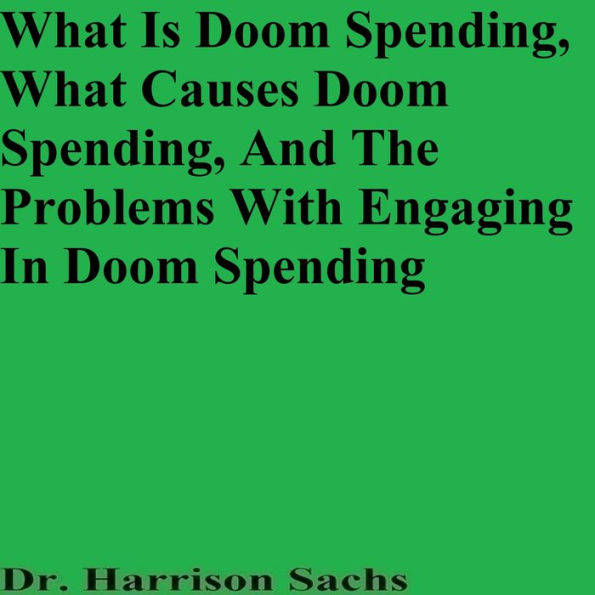5
1

What Is Doom Spending, What Causes Doom Spending, And The Problems With Engaging In Doom Spending
by Dr. Harrison Sachs
Dr. Harrison Sachs

What Is Doom Spending, What Causes Doom Spending, And The Problems With Engaging In Doom Spending
by Dr. Harrison Sachs
Dr. Harrison Sachs
eBook
$14.99
Available on Compatible NOOK devices, the free NOOK App and in My Digital Library.
WANT A NOOK?
Explore Now
Related collections and offers
LEND ME®
See Details
14.99
In Stock
Overview
This essay sheds light on what is the doom spending, demystifies what causes doom spending, and expounds upon the problems with engaging in doom spending. Doom spending refers to the activity of poor people who lack financial stability and financial security undergoing debt financing to purchase products and services as as a means to cope with stress that they would otherwise be unable to make without undergoing debt financing to do so due to them lacking the requisite amount of fiat currency to do so. Poor people who engage in doom spending often have a bleak outlook about their economic future and often cannot envision the economy being metaphorically thrust out of a perpetual economic depression anytime in the imminent future. When poor people engage in doom spending, they accrue sizeable debt since they undergo debt financing to purchase products and services. Undergoing debt financing to make purchases can bear enormous recurring interest fees. Undergoing debt financing to make purchases can also bear late fees if an indebted person is unable to make debt financing payments in a punctual manner. Undergoing debt financing to make purchases can be ineffably calamitous to an indebted person's financial health. Nothing beneficent can ever ensue from being saddled with debt. When poor people engage in doom spending, they often purchase products that are not deemed to be essential products. When poor people engage in doom spending, they often also purchase services that are not deemed to be essential services. When poor people engage in doom spending, they purchase products and services that they desire to procure even though these products and services are not deemed to be basic needs. Examples of poor people engaging in doom spending encompass them undergoing debt financing to be able to attend concerts at concert venues, attend professional sports events at sports stadiums, watch movies at movie theaters, watch Broadway shows at Broadway theaters, eat out at restaurants, go on vacations on cruise ships, and go on vacations at all-inclusive resorts. There are an exorbitant amount of disparate ways in which people can engage in doom spending since there are a cornucopia of products and services that are not deemed to be basic needs that poor people can purchase by undergoing debt financing to do so. When poor people engage in doom spending by undergoing debt financing to purchase products and services, then they become all the more vulnerable to accruing an enormous amount of debt. Some of the different types of debts that poor people who engage in doom spending are susceptible to accruing encompass credit card debt, "buy now, pay later loan" debt, and payday loan debt. Since credit card debts, "buy now, pay later loan" debt, and payday loan debts are uncollateralized debts that can be rapidly accrued by a person who lacks collateralized assets, such as real estate properties and cars, poor people are highly prone to accruing a sizeable amount of uncollateralized debts. Even though engaging in doom spending can potentially educe a pleasurable ephemeral dopamine-release sensation, it still nonetheless comes at a steep cost of undermining your future earnings potential when you undergo debt financing to finance purchases. A person should abstain from undergoing debt financing to finance purchases since doing so cannot only bear exorbitant recurring interest fees, but can also undermine a person's future earnings potential since earmarking fiat currency towards paying recurring interest fees depletes a person's fiat currency that could otherwise have been allocated towards acquiring investment securities that are able to furnish a person with recurring investment income, such as safe stocks that have high dividend yields from highly profitable companies, AAA-rated long-term corporate bonds from highly profitable companies, index mutual funds that have a stellar performance track record, actively managed mutual funds that have a stellar performance track record, index exchange traded funds that have a stellar performance track record, and actively managed exchange traded funds that have a stellar performance track record. An investor should be acutely aware that in spite of how enticing an investment security may be, he is not guaranteed to reap a positive return on investment if he decides to invest in purchasing an investment security. An investor should only consider investing in purchasing investment securities if he can afford to risk potentially squandering investment dollars. Even though engaging in doom spending is perceived by other people to be an act of financial imprudence for poor people to engage in, poor people are often eminently recalcitrant to abstain from undergoing debt financing to purchase products and services in contexts in which they would otherwise be unable to purchase without undergoing debt financing to do so due to them lacking the requisite amount of fiat currency to do so.

Product Details
| BN ID: | 2940186057918 |
|---|---|
| Publisher: | Dr. Harrison Sachs |
| Publication date: | 06/01/2024 |
| Sold by: | Barnes & Noble |
| Format: | eBook |
| File size: | 77 KB |
From the B&N Reads Blog
Page 1 of
